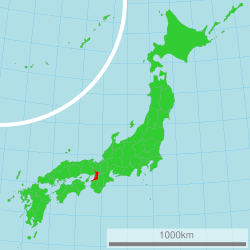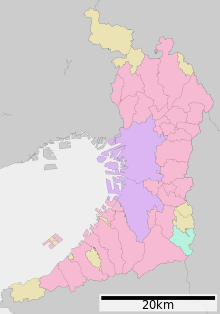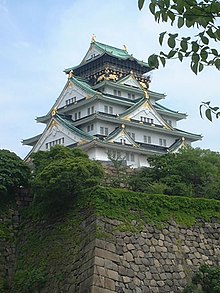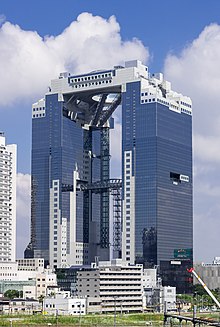Osaka Prefecture
Osaka Prefecture
Osaka phủ | |
|---|---|
| Japanese transcription(s) | |
| •Japanese | Osaka phủ |
| •Rōmaji | Ōsaka-fu |
 | |
 | |
| Coordinates:34°41′11″N135°31′12″E/ 34.68639°N 135.52000°E | |
| Country | |
| Region | Kansai |
| Island | Honshu |
| Capital | Osaka |
| Subdivisions | Districts:5,Municipalities:43 |
| Government | |
| •Governor | Hirofumi Yoshimura |
| Area | |
| • Total | 1,905.14 km2(735.58 sq mi) |
| • Rank | 46th |
| Population (1 July 2019) | |
| • Total | 8,823,358 |
| • Rank | 3rd |
| • Density | 4,600/km2(12,000/sq mi) |
| GDP | |
| • Total | JP¥41,188 billion US$377.9 billion (2019) |
| ISO 3166 code | JP-27 |
| Website | www |
| Symbols of Japan | |
| Bird | Bull-headed shrike(Lanius bucephalus) |
| Flower | Japanese apricot(Prunus mume) Primrose (Primula sieboldii) |
| Tree | Ginkgo tree (Ginkgo biloba) |
Osaka Prefecture(Osaka phủ,Ōsaka-fu,pronounced[oːsakaɸɯ])is aprefectureofJapanlocated in theKansai regionofHonshu.[2]Osaka Prefecture has a population of 8,778,035 (as of 1 April 2022[update]) and has a geographic area of 1,905square kilometres(736sq mi). Osaka Prefecture bordersHyōgo Prefectureto the northwest,Kyoto Prefectureto the north,Nara Prefectureto the southeast, andWakayama Prefectureto the south.
Osakais the capital and largest city of Osaka Prefecture, and thethird-largest cityin Japan, with other major cities includingSakai,Higashiōsaka,andHirakata.[3]Osaka Prefecture is located on the western coast of theKii Peninsula,forming the western is open toOsaka Bay.Osaka Prefecture is the third-most-populous prefecture, but by geographic area the second-smallest; at 4,600 inhabitants per square kilometre (12,000/sq mi) it is the second-mostdensely populated,below onlyTokyo.Osaka Prefecture is one of Japan's two "urban prefectures"using the designationfu( phủ ) rather than the standardkenfor prefectures, along with Kyoto Prefecture. Osaka Prefecture forms the center of theKeihanshinmetropolitan area, the second-most-populatedurban region in Japanafter theGreater Tokyo areaand one of the world's most productive regions byGDP.
History
[edit]| Year | Pop. | ±% p.a. |
|---|---|---|
| 1890 | 1,324,216 | — |
| 1903 | 1,823,456 | +2.49% |
| 1913 | 2,461,067 | +3.04% |
| 1920 | 2,587,847 | +0.72% |
| 1925 | 3,059,502 | +3.41% |
| 1930 | 3,540,017 | +2.96% |
| 1935 | 4,297,174 | +3.95% |
| 1940 | 4,792,966 | +2.21% |
| 1945 | 2,800,958 | −10.19% |
| 1950 | 3,857,047 | +6.61% |
| 1955 | 4,618,308 | +3.67% |
| 1960 | 5,504,746 | +3.57% |
| 1965 | 6,657,189 | +3.87% |
| 1970 | 7,620,480 | +2.74% |
| 1975 | 8,278,925 | +1.67% |
| 1980 | 8,473,446 | +0.47% |
| 1985 | 8,668,095 | +0.46% |
| 1990 | 8,734,516 | +0.15% |
| 1995 | 8,797,268 | +0.14% |
| 2000 | 8,805,081 | +0.02% |
| 2005 | 8,817,166 | +0.03% |
| 2010 | 8,865,245 | +0.11% |
| 2015 | 8,838,908 | −0.06% |
| source:[4] | ||
Prior to the Meiji Restoration, the modern-day area of Osaka Prefecture was split betweenKawachi,Izumi,[5][6]andSettsuprovinces.[7]
Osaka Prefecture was created on June 21, 1868, at the very beginning of theMeiji era.[8]During the instigation ofFuhanken Sanchiseiin 1868, the prefecture received its suffixfu,designating it as a prefecture.
On September 1, 1956, the city ofOsakawas promoted to acity designated by government ordinanceand thereby divided into 24wards.Sakaibecame the second city in the prefecture to be promoted to a city designated by government ordinance on April 1, 2006, and was divided into seven wards.
In 2000,Fusae Otabecame Japan's first female governor when she replacedKnock Yokoyama,who resigned after prosecution forsexual harassment.[9]Tōru Hashimoto,previously famous as a counselor on television, was elected in 2008 at the age of 38, becoming the youngest governor in Japan.[10]
On June 18, 2018, anearthquakestruck the northern region of the prefecture. It killed 4 people and caused minor damage acrossGreater Osaka.[11]
Proposed reorganisation
[edit]In 2010, theOsaka Restoration Associationwas created with backing by Governor Tōru Hashimoto, with hopes of reforming Osaka Prefecture into the Osaka Metropolis and merging with the City of Osaka.[10]In the 2011 local elections, the association was able to win the majority of the prefectural seats and Hashimoto was elected as mayor of Osaka.
Areferendumon the issue was held in 2015 and was defeated with 50.38% of voters opposed to the plan.[10]A second referendum in 2020 was rejected by 50.6% of voters.[12]
Geography
[edit]Osaka Prefecture neighbors the prefectures ofHyōgoandKyotoin the north,Narain the east andWakayamain the south. TheYodoand Yamato Rivers flow through the prefecture.
Prior to the construction ofKansai International Airport,Osaka was the smallest prefecture in Japan. The artificial island on which the airport was built added enough area to make it slightly larger thanKagawa Prefecture.[13][14]
As of 1 April 2012, 11% of the total land area of the prefecture was designated asNatural Parks,namelyKongō-Ikoma-KisenandMeiji no Mori MinōQuasi-National Parks andHokusetsuandHannan-MisakiPrefectural Natural Parks.[15]
Municipalities
[edit]
Government Ordinance Designated CityCityTownVillage



Since 2005, Osaka consists of 43municipalities:33cities,ninetownsand onevillage.As of 2021, the 33 cities include twodesignated major cities,sevencore citiesand two(transitional) special case cities(after legal abolition in 2015, to be replaced with the core city system in the 2020s).
| Flag, namew/o suffix | Full name | District (-gun) |
Area (km2) | Population | Map | LPEcode (w/o pref. [27...], checksum [-x]) | ||
|---|---|---|---|---|---|---|---|---|
| Japanese | transcription | translation | ||||||
| Đại chợ phía đông | Daitō-shi | Daitō City | – | 18.27 | 119,329 | 
|
218 | |
| Đằng giếng chùa thị | Fujidera-shi | Fujidera City | – | 8.89 | 65,075 | 
|
226 | |
| Vũ kéo dã thị | Habikino-shi | Habikino City | – | 26.44 | 113,256 | 
|
222 | |
| Phản nam thị | Hannan-shi | Hannan City | – | 36.1 | 55,798 | 
|
232 | |
| Đông Osaka thị | Higashi-Ōsaka-shi | Higashi-Osaka City (East Osaka City) |
– | 61.78 | 495,011 | 
|
227 | |
| Cái phương thị | Hirakata-shi | Hirakata City | – | 65.08 | 401,449 | 
|
210 | |
| Tì mộc thị | Ibaraki-shi | Ibaraki City | – | 76.52 | 280,562 | 
|
211 | |
| Trì điền thị | Ikeda-shi | Ikeda City | – | 22.09 | 103,028 | 
|
204 | |
| Cùng tuyền thị | Izumi-shi | IzumiCity | – | 84.98 | 186,370 | 
|
219 | |
| Tuyền đại Tân Thị | Izumi-Ōtsu-shi | Izumi-Ōtsu City (as opposed toŌtsu City in Ōmi Province) |
– | 13.36 | 75,398 | 
|
206 | |
| Tuyền tá dã thị | Izumi-Sano-shi | Izumi-Sano City (as opposed toSano City in Shimotsuke Province) |
– | 55.03 | 100,649 | 
|
213 | |
| Môn thật thị | Kadoma-shi | Kadoma City | – | 12.28 | 124,516 | 
|
223 | |
| Bối trủng thị | Kaizuka-shi | Kaizuka City | – | 43.99 | 88,345 | 
|
208 | |
| Bách nguyên thị | Kashiwara-shi | Kashiwara City | – | 25.39 | 76,383 | 
|
221 | |
| Giao dã thị | Katano-shi | Katano City | – | 25.55 | 76,383 | 
|
230 | |
| Hà nội trường dã thị | Kawachi-Nagano-shi | Kawachi-Nagano City (as opposed toNagano City in Shinano Province) |
– | 109.61 | 105,872 | 
|
216 | |
| Ngạn hòa điền thị | Kishiwada-shi | Kishiwada City | – | 72.68 | 197,629 | 
|
202 | |
| Tùng nguyên thị | Matsubarashi | Matsubara City | – | 16.66 | 121,125 | 
|
217 | |
| Thành phố Minoh | Minoo-shi | Minoo City | – | 47.84 | 134,435 | 
|
220 | |
| Thủ khẩu thị | Moriguchi-shi | Moriguchi City | – | 12.73 | 143,877 | 
|
209 | |
| Phòng ngủ xuyên thị | Neyagawa-shi | Neyagawa City | – | 24.73 | 236,758 | 
|
215 | |
| Osaka thị | Ōsaka-shi | Osaka City | – | 225.21 | 2,668,586 | 
|
100 | |
| Osaka hiệp sơn thị | Ōsaka-Sayama-shi | Osaka-Sayama City (as opposed toSayama City in Saitama) |
– | 11.86 | 57,993 | 
|
231 | |
| Giới thị | Sakai-shi | Sakai City | – | 149.82 | 828,741 | 
|
140 | |
| Tuyền nam thị | Sennan-shi | Sennan City (Sen[shū]South City) (afterSennan District) |
– | 48.48 | 62,076 | 
|
228 | |
| Nhiếp Tân Thị | Settsu-shi | SettsuCity | – | 14.88 | 85,290 | 
|
224 | |
| Bốn điều 畷 thị | Shijōnawate-shi | Shijōnawate City | – | 18.74 | 55,832 | 
|
229 | |
| Thổi điền thị | Suita-shi | Suita City | – | 36.11 | 378,322 | 
|
205 | |
| Cao thạch thị | Takaishi-shi | Takaishi City | – | 11.35 | 56,583 | 
|
225 | |
| Cao khuê thị | Takatsuki-shi | Takatsuki City | – | 105.31 | 350,914 | 
|
207 | |
| Phú điền lâm thị | Tondabayashi-shi | Tondabayashi City | – | 39.66 | 112,993 | 
|
214 | |
| Phong trung thị | Toyonaka-shi | Toyonaka City | – | 36.38 | 396,014 | 
|
203 | |
| Tám đuôi thị | Yaoshi | Yao City | – | 41.71 | 268,013 | 
|
212 | |
| Ngàn sớm xích phản thôn | Chihaya-Akasaka-mura | Chihaya-Akasaka Village | Minamikawachi | 37.38 | 5,467 | 
|
383 | |
| Hà Nam đinh | Kanan-chō | Kanan Town | 25.26 | 16,027 | 
|
382 | ||
| Thái Tử đinh | Taishi-chō | Taishi Town | 14.17 | 13,634 | 
|
381 | ||
| Hùng lấy đinh | Kumatori-chō | Kumatori Town | Sennan | 17.23 | 43,988 | 
|
361 | |
| Giáp đinh | Misakichō | Misaki Town | 49.08 | 16,267 | 
|
366 | ||
| Điền mông đinh | Tajiri-chō | Tajiri Town | 4.96 | 8,377 | 
|
362 | ||
| Có thể thế đinh | Nose-chō | Nose Town | Toyono | 98.68 | 9,971 | 
|
322 | |
| Phong có thể đinh | Toyono-chō | Toyono Town | 34.37 | 19,519 | 
|
321 | ||
| Đảo bổn đinh | Shimamoto-chō | Shimamoto Town | Mishima | 16.78 | 29,970 | 
|
301 | |
| Trung cương đinh | Tadaoka-chō | Tadaoka Town | Senboku | 4.03 | 17,187 | 
|
341 | |
| Osaka phủ | Ōsaka-fu | Osaka Prefecture | – | 1,905.14 | 8,823,358 | 
|
000 ISO: JP-27 | |
Mergers
[edit]After the modern reactivation ofdistrictsin 1878/79, Osaka, includingSakaiwhich was only merged into Osaka in 1881, consisted of 5 urban districts(-ku)and 27 rural districts(-gun),excluding 15 districts in Yamato Province which was later separated from Osaka asNara Prefecturein 1887. When the prefectures were subdivided into modern municipalities in 1889, the five urban districts were turned into two district-independent cities: Osaka City and Sakai City, and Osaka's [rural] districts were subdivided into 12 towns and 310 villages. After Osaka City had absorbed many surrounding municipalities in the interwar/Taishō period, the number of municipalities in Osaka had already dropped to 149 by 1953. The Great Shōwa mergers of the 1950s reduced the total to 47 by 1961, including 26 cities by then. The current total of 43 was reached during the Great Heisei mergers in 2005.
Economy
[edit]







The gross prefecture product of Osaka for the fiscal year 2004 was ¥38.7 trillion, second after Tokyo with an increase of 0.9% from the previous year. This represented approximately 48% of the Kinki region. The per capita income was ¥3.0 million, seventh in the nation.[16]Commercial sales the same year was ¥60.1 trillion.[17]
Overshadowed by such globally renowned electronics giants asPanasonicandSharp,the other side of Osaka's economy can be characterized by its Small and Medium Enterprises (SMEs) activities. The number of SMEs based in Osaka in 2006 was 330,737, accounting for 99.6% of the total number of businesses in the prefecture.[18]While this proportion is similar to other prefectures (the average nationwide was 99.7%), the manufactured output of the SMEs amounted to 65.4% of the total within the prefecture, a rate significantly higher than Tokyo's 55.5%, orKanagawa's 38.4%.[19]One model from Osaka of serving the public interest and restimulating the regional economy, combined with industry-education cooperation efforts, is the Astro-Technology SOHLA,[20]with its artificial satellite project.[21]Having originally started from a gathering ofHigashiosakabased SMEs, Astro-Technology SOHLA has not only grown into a Kansai region-wide group but has also won support from the government, through technology and material support from Japan Aerospace Exploration Agency (JAXA),[22]and financial support from NEDO.[23][24]
TheOsaka Securities Exchange,specializing in derivatives such as Nikkei 225 Futures, is based in Osaka.
There are many electrical, chemical, pharmaceutical, heavy industry, food, and housing companies in Osaka Prefecture.
Major companies
[edit]Major factories and research institutes
[edit]Demographics
[edit]
According to the 2005 Population Census of Japan, Osaka prefecture has a population of 8,817,166, an increase of 12,085, or 0.14%, since the Census of year 2000.[25]
As of 2022 this prefecture has about 93,000ethnic Korean persons,the largest such population of any prefecture in Japan.[26]Osaka City.As of 2013 most ethnic Korean children attend ordinary Japanese public schools, although some Korean schools operated by theChongryonand classes for ethnic Koreans had opened in the prefecture. During theJapanese rule of Koreamany ethnic Koreans came to the Osaka area to look for work. Many people fromJejucame to the Osaka area after a 1922 ferry line between Osaka and Jeju opened. DuringWorld War IIJapanese authorities forced additional ethnic Koreans to move to the Osaka area.[27]
Temples and shrines
[edit]Museums
[edit]- National Museum of Ethnology, Japan[2]
- Open-Air Museum of Old Japanese Farm Houses(Hattori Ryokuchi Park)
- OSTEC (Osaka Science and Technology Center) Exhibition Hall
- Japan Folk CraftsMuseum, OsakaOsaka Nhật Bản dân vân quán
Education
[edit]Public elementary and junior high schools in the prefecture are operated by the municipalities. Public high schools are operated by theOsaka Prefectural Board of Education.
Universities
[edit]- Kansai Medical University(Hirakata,Osaka)
- Osaka University(ToyonakaandSuita)
- formerOsaka University of Foreign Studies(Minoh)
- Osaka Kyoiku University(Kashiwara)
- Osaka City University(Osaka city)
- Osaka Prefecture University(Sakai)
- Kansai University(Suita,Takatsuki,Osaka city)
- Kindai University(Higashiosaka)
- Kansai Gaidai University(Hirakata) (Kansai University of Foreign Studies)
- Osaka International Educational University(Moriguchi)
- Osaka University of Health and Sport sciences (Kumatori)
- Osaka University of Commerce(Higashiosaka)
- Osaka University of Economic and Law (Yao)
- Osaka College of Music(Toyonaka)
- Osaka Electro Communication University (Neyagawa)
- Osaka Gakuin University(Suita)
- Otemon Gakuin University(Ibaraki)
- Hannan University(Matsubara)
- Setsunan University(Neyagawa)
- St Andrews University(Momoyama Gakuin University) (Izumi)
- Taisei Gakuin University(Mihara, Sakai)
- Tezukayama Gakuin University(Ōsakasayama,Sakai)
Parks
[edit]- TheExpo Commemoration Park(Suita) held theExpo '70.It is about 260haand includes aJapanese garden,National Museum of Art, Osaka,and the amusement park "Expoland".
- Hattori Ryokuchi Park(Toyonaka), about 150 ha.
- Tsurumi Ryokuchi Park(Osaka), about 100 ha. The horticulture exposition ofExpo '90was held here.[28]
- Nagai Park (Osaka), about 66ha.TheIAAF World Championships in Athleticswere held in 2007 atNagai Stadiumin this park.
- Osaka CastlePark (Osaka), about 106 ha.
- Nakanoshima Park(Osaka), housing the Museum of Oriental Ceramics, public hall,Osaka Prefectural Nakanoshima Library,and the city hall of Osaka.
- Yamadaike Park(Osaka), about 73.7 ha.
- Osaka Prefectural Park (Hirakata), operated by Osaka Prefecture.[citation needed]
Transportation
[edit]Rail
[edit]- JR Central
- JR West
- Osaka Metro
- Keihan Electric Railway
- Kintetsu
- Hankyu
- Nose Electric Railway
- Hanshin Electric Railway
- Nankai Electric Railway
- Senboku Rapid Railway
- Mizuma Railway
- Kita-Osaka Kyuko Railway
People movers
[edit]Road
[edit]
Osaka (Ōsaka) in Northern Osaka
なにわ (Naniwa) in Osaka City, namedNaniwa as Imperial capital in antiquity
Cùng tuyền (Izumi) in Southern Osaka≈Izumi Province+Southern Kawachi
Giới (Sakai) in Sakai City
Expressways
[edit]- Meishin Expressway
- Chugoku Expressway
- Hanshin Expressway
- Nishi-Meihan Expressway
- Second Keihan Highway
- Hanwa Expressway
- Second Hanna Highway
- Minami Hanna Highway
National highways
[edit]- National Route 1
- National Route 2
- National Route 25
- National Route 26
- National Route 43
- National Route 163
- National Route 165
- National Route 166
- National Route 168
- National Route 170
- National Route 171
- National Route 173
- National Route 176
- National Route 307
- National Route 308
- National Route 309
- National Route 310
- National Route 371
- National Route 423
- National Route 477
- National Route 479
- National Route 480
- National Route 481
Airports
[edit]- Osaka International Airport- Domestic flights
- Kansai International Airport- International and domestic flights
Sister regions
[edit]Osaka Prefecture has sister region relationships with:[29]
 Shanghai,China (1980)
Shanghai,China (1980) East Java,Indonesia (1984)
East Java,Indonesia (1984) Rotterdam,Netherlands (1984)
Rotterdam,Netherlands (1984) Val-d'Oise,France (1987)
Val-d'Oise,France (1987) Queensland,Australia (1988)
Queensland,Australia (1988) Primorsky Krai,Russia (1992)
Primorsky Krai,Russia (1992) California,United States (1994)
California,United States (1994) Lombardy,Italy (2002)
Lombardy,Italy (2002) Dubai,United Arab Emirates (2002)
Dubai,United Arab Emirates (2002) Ho Chi Minh City,Vietnam (2007)
Ho Chi Minh City,Vietnam (2007)
Sports
[edit]
The sports teams listed below are based in Osaka.
Association football
[edit]League
[edit]Baseball
[edit]Basketball
[edit]Volleyball
[edit]Rugby union
[edit]Prefectural symbols
[edit]The symbol of Osaka Prefecture, called thesennari byōtanor "thousand gourds", was originally the crest ofToyotomi Hideyoshi,the feudal lord ofOsaka Castle.
See also
[edit]- List of twin towns and sister cities in Japan
- Osaka Culture Prize
- Osaka Eco Agricultural Products
- Osaka Metropolis plan
- Politics of Osaka
Notes
[edit]- ^"2020 niên độ quốc dân kinh tế tính toán ( 2015 năm tiêu chuẩn cơ bản ・2008SNA ): Kinh tế xã hội tổng hợp viện nghiên cứu - Nội Các phủ".Nội Các phủ ホームページ(in Japanese).Retrieved2023-05-18.
- ^Nussbaum, Louis-Frédéric. (2005). "Osaka-fu" inJapan Encyclopedia,p. 759,p. 759, atGoogle Books;"Kansai" inp. 477,p. 477, atGoogle Books
- ^Nussbaum, "Osaka" inp. 759,p. 759, atGoogle Books
- ^"Statistics Bureau Home Page".stat.go.jp.
- ^Osaka phủ giáo dục ủy ban (2002-03-29)."Ngạn hòa điền thành tích".Comprehensive Database of Archaeological Site Reports in Japan.Retrieved2016-09-02.
- ^Tuyền nam thị giáo dục ủy ban (1987-09-21)."Hải sẽ chùa".Comprehensive Database of Archaeological Site Reports in Japan.Retrieved2016-09-02.
- ^Nussbaum, "Provinces and prefectures" inp. 780,p. 780, atGoogle Books
- ^"Osaka の あゆみ (History of Osaka)"(in Japanese).Retrieved2007-03-12.The creation of Osaka prefecture took place slight earlier than many other prefectures, that had to wait forabolition of the han systemin 1871.
- ^Tolbert, Kathryn."Election of First Female Governor Boosts Japan's Ruling Party",The Washington Post,February 8, 2000.
- ^abcHarding, Robin (June 11, 2018)."Battle to remodel Osaka is legacy of Japan's Trump".The Financial Times.Archived fromthe originalon 2022-12-10.RetrievedOctober 5,2021.
- ^Kaneko, Kaori; Foster, Malcolm (June 18, 2018)."Magnitude 6.1 quake in Japan's Osaka area kills four, halts factories".Reuters.RetrievedOctober 5,2021.
- ^Johnston, Eric (November 2, 2020)."Osaka referendum defeat raises questions about future of city's politics".The Japan Times.RetrievedOctober 5,2021.
- ^"Bình thành 10 năm cả nước đều đạo phủ huyện nội thành đinh thôn の diện tích の công biểu について(Official announcement on the national territory and area of 1998, by prefectures, cities, districts, towns and villages)"Archived2003-06-11 at theWayback Machine,Geographical Survey Institute, Government of Japan,January 29, 1999.
- ^"コラム Vol.017 cả nước đều đạo phủ huyện nội thành đinh thôn diện tích điều (Column:" National Area Investigation "vol.017)"Archived2007-09-28 at theWayback Machine,Alps Mapping K.K.,March 8, 2001.
- ^"General overview of area figures for Natural Parks by prefecture"(PDF).Ministry of the Environment.Retrieved9 August2012.
- ^"Bình thành 16 niên độ の huyện dân kinh tế tính toán について (Prefectural Economy for the fiscal year 2004 based on 93SNA)Cabinet Office, Government of Japan"(PDF)(in Japanese). Archived fromthe original(PDF)on 2007-06-14.Retrieved2007-03-13.
- ^"Osaka phủ dân kinh tế tính toán (Osaka Prefectural Economy based on 93SNA)Osaka Prefectural Government"(PDF)(in Japanese). Archived fromthe original(PDF)on 2007-06-14.Retrieved2007-03-13.
- ^"2006 White Paper on Small and Medium Enterprises in Japan, Japan Small Business Research Institute (Japan)"(PDF).Archived fromthe original(PDF)on 2007-03-23.Retrieved2007-03-13.
- ^"なにわ の kinh tế データ (The Naniwa Economy Data)"(PDF)(in Japanese). Archived fromthe original(PDF)on 2007-06-14.Retrieved2007-03-13.
- ^"Astro-Technology SOHLA"(in Japanese). Archived fromthe originalon 2007-03-09.Retrieved2007-03-14.
- ^"Japan Advertising Council".Archived fromthe originalon 2007-03-01.Retrieved2007-03-14.For details on the campaign featuring SOHLA, navigate through the Japanese page to the 2003 campaign listing, at entry "Đông Osaka の nhân công vệ tinh" (Higashiosaka's Satellite)[1]Archived2007-03-12 at theWayback Machine
- ^""Smaller firms build a satellite"City of Osaka, Chicago Office".Archived fromthe originalon 2007-09-29.Retrieved2007-03-14.
- ^The New Energy and Industrial Technology Development Organization
- ^""Study of PETSAT"NEDO, 2005"(PDF)(in Japanese and English). Archived fromthe original(PDF)on 2007-06-14.Retrieved2007-03-14.
- ^"Table 1: Osaka phủ の dân cư の chuyển dời ( Population Change of Osaka Prefecture)"(in Japanese). Osaka Prefectural Government. Archived fromthe originalon 2007-01-05.Retrieved2007-03-13.
- ^"Osaka phủ の quốc tịch ・ địa vực ( xuất thân mà ) đừng ở lưu người nước ngoài số"(PDF).Retrieved2024-07-14.
- ^Aoki, Eriko. "Korean children, textbooks, and educational practices in Japanese primary schools" (Chapter 8). In: Ryang, Sonia.Koreans in Japan: Critical Voices from the Margin(Routledge Studies in Asia's Transformations).Routledge,October 8, 2013.ISBN1136353054,9781136353055. Start: p.157.CITED: p.166.
- ^Tài đoàn pháp nhân quốc tế hoa と lục の bác lãm sẽ kỷ niệm hiệp hội: English: Expo'90 FoundationArchived2011-10-21 at theWayback Machine
- ^"Osaka's sister regions".pref.osaka.lg.jp(in Japanese).Retrieved2023-08-07.
References
[edit]- Nussbaum, Louis-Frédéric and Käthe Roth. (2005).Japan encyclopedia.Cambridge:Harvard University Press.ISBN978-0-674-01753-5;OCLC 58053128









